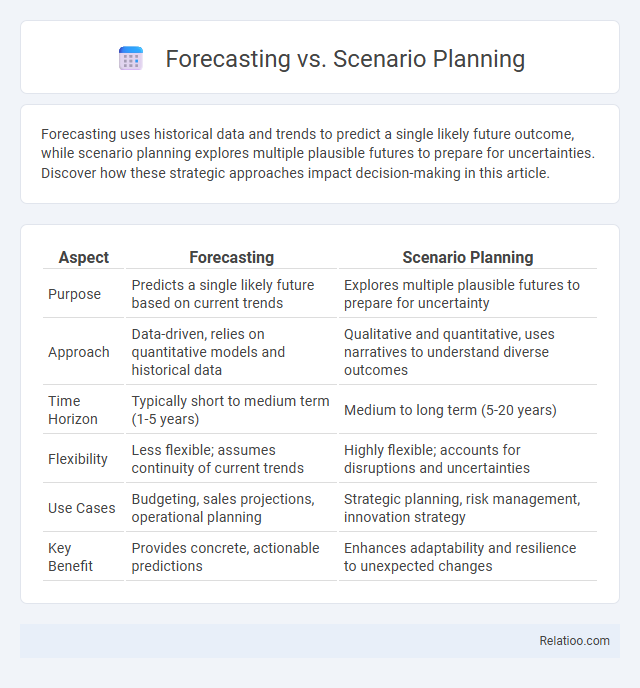Forecasting uses historical data and trends to predict a single likely future outcome, while scenario planning explores multiple plausible futures to prepare for uncertainties. Discover how these strategic approaches impact decision-making in this article.
Table of Comparison
| Aspect | Forecasting | Scenario Planning |
|---|---|---|
| Purpose | Predicts a single likely future based on current trends | Explores multiple plausible futures to prepare for uncertainty |
| Approach | Data-driven, relies on quantitative models and historical data | Qualitative and quantitative, uses narratives to understand diverse outcomes |
| Time Horizon | Typically short to medium term (1-5 years) | Medium to long term (5-20 years) |
| Flexibility | Less flexible; assumes continuity of current trends | Highly flexible; accounts for disruptions and uncertainties |
| Use Cases | Budgeting, sales projections, operational planning | Strategic planning, risk management, innovation strategy |
| Key Benefit | Provides concrete, actionable predictions | Enhances adaptability and resilience to unexpected changes |
Understanding Forecasting: Definition and Purpose
Forecasting involves predicting future outcomes based on historical data, trends, and statistical models to inform decision-making and reduce uncertainty. Unlike scenario planning, which explores multiple possible futures to prepare for various contingencies, forecasting aims for the most likely future trajectory. Your ability to understand forecasting empowers you to anticipate market shifts and allocate resources effectively, ensuring strategic alignment with expected developments.
Scenario Planning Explained: Key Concepts
Scenario planning involves creating detailed, plausible future contexts to help organizations anticipate risks and opportunities. Unlike forecasting, which projects a single expected outcome based on current trends, scenario planning explores multiple potential futures to guide strategic decisions. Your ability to prepare for diverse possibilities enhances resilience and informs long-term vision development by integrating uncertainty and complexity into planning processes.
Core Differences Between Forecasting and Scenario Planning
Forecasting relies on quantitative data and historical trends to predict a single most likely future, providing concrete projections for decision-making. Scenario planning explores multiple plausible futures based on varying assumptions and uncertainties, helping Your organization prepare for diverse outcomes instead of a fixed prediction. The core difference lies in forecasting's focus on probability and precision, while scenario planning emphasizes flexibility and strategic readiness.
Techniques Used in Forecasting
Techniques used in forecasting include time series analysis, causal models, and qualitative methods like Delphi surveys and expert judgment. Time series analysis relies on historical data patterns to predict future trends, while causal models identify relationships between variables to estimate outcomes. Qualitative techniques gather insights from industry experts to anticipate changes that quantitative data might not reveal.
Methods and Tools for Scenario Planning
Scenario planning employs techniques like cross-impact analysis, simulations, and Delphi surveys to explore multiple future outcomes and evaluate uncertainties. Forecasting relies on quantitative models such as time series analysis and regression to predict future trends based on historical data. Your strategic decisions benefit from integrating scenario planning tools like scenario matrices, environmental scanning, and trend extrapolation to visualize diverse futures and enhance long-term vision development.
Strengths and Limitations of Forecasting
Forecasting excels in predicting short to medium-term outcomes based on historical data and current trends, enabling precise budget allocation and resource planning. Its limitations include vulnerability to unexpected disruptions and an inability to account for radical changes or novel scenarios, which can lead to inaccurate projections. Unlike scenario planning and long-term visioning, forecasting offers less flexibility and may overlook complex, emergent dynamics in uncertain environments.
Advantages and Challenges of Scenario Planning
Scenario planning offers the advantage of preparing Your business for multiple future possibilities by exploring diverse, plausible outcomes and their impacts. It enhances strategic flexibility and risk management but requires significant time, resources, and data accuracy to create meaningful scenarios. The challenges include dealing with uncertainty, potential complexity overload, and ensuring stakeholder alignment throughout the scenario development process.
When to Use Forecasting vs Scenario Planning
Forecasting relies on historical data and trends to predict probable future outcomes, making it ideal when your business environment is stable and variables are well-understood. Scenario planning is suited for uncertain or rapidly changing environments where multiple plausible futures need consideration, helping You prepare flexible strategies for various potential developments. Long-term vision provides overall direction and goals but lacks specific predictive power, so it's best combined with forecasting or scenario planning for actionable insights.
Real-World Business Applications and Case Studies
Forecasting uses historical data and statistical models to predict short- to medium-term business trends, enabling companies like Amazon to optimize inventory management and demand planning. Scenario planning explores multiple plausible futures by examining uncertainties and variables, as seen in Shell's energy sector strategy that prepared the company for shifts in oil markets and renewable energy adoption. Long-term vision aligns organizational goals with future aspirations, exemplified by Tesla's commitment to sustainable transportation and energy innovation shaping its product development and market positioning over decades.
Integrating Forecasting and Scenario Planning for Strategic Decision-Making
Integrating forecasting and scenario planning enhances strategic decision-making by combining quantitative data trends with qualitative insights into potential future uncertainties. Forecasting uses historical data and statistical models to predict likely future outcomes, while scenario planning explores multiple plausible futures to prepare flexible strategies. This integration enables organizations to anticipate risks, adapt to market changes, and make informed long-term decisions that align with their strategic vision.

Infographic: Forecasting vs Scenario planning
 relatioo.com
relatioo.com